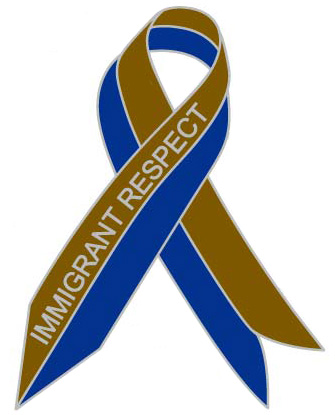Jason Gaspar, left, demonstrating food preparation with homegrown vegetables at Immigrant Movement International headquarters.
Holland Cotter
New York Times
June 21, 2012
Para la versión en español siga bajando.
Artists have always blurred the lines among art, life and politics. Joseph Beuys planted thousands of trees as ecological sculpture. Gordon Matta-Clark stockpiled useless slivers of Manhattan real estate to illustrate the absurdity of property ownership. The tradition continues in the work of the Cuban-born artist Tania Bruguera, who has created the equivalent of a full-time performance piece called the Immigrant Movement International in Corona, Queens.
Conceived as a gesture of solidarity with people living illegally in countries not their own, the movement has headquarters in a storefront on Roosevelt Avenue. There, free and seven days a week, a tiny staff and a roster of volunteers, many of them artists, offer a program of practical assistance and consciousness-raising activities to neighborhood residents, many of whom are new arrivals from Ecuador and Mexico.
Services include legal advice and computer instruction, but there are also reading lessons that double as introductions to art history, with an emphasis on the difficult lives of artists in the past; health classes that incorporate meditation and tai chi, linking an isolated Latin American population to the borough’s Asian cultures; and theater workshops that function as safe places to work out stress, reimagine reality and rehearse political interventions.
One goal of the Immigrant Movement International, defined in a collectively written manifesto, is to bring the cause of civil rights for immigrants into the public sphere. How to do so effectively is the question. And this is the focus of a series of community meetings, the first of which I sat in on last week.
It was evident from the discussion that the merging of life and art that Ms. Bruguera envisions is still an evolving concept here. Some people wanted straightforward protest marches; others mulled subtler forms of mass demonstration learned from, among other sources, Occupy Wall Street, with its roots in street theater. What was clear was that everyone — about 50 people — understood the basic politics-as-performance idea and were ready to go with it.
When Ms. Bruguera first set up the project in Corona in 2011, with financing from Creative Time and the Queens Museum of Art, skeptics assumed that it was an artist’s ego trip and that she wouldn’t stay. A year and a half later, and with most of the money gone, the work is still in progress, and Ms. Bruguera is still there, living over the storefront.
Is it art? Tired question, to which nearly half a century of history responds: yes. For sure, it’s art I’ll be following this summer. Both before and after the Chelsea galleries close for vacation, a lot will be happening in community meetings in Corona, as more ideas for election-year actions are sketched out, then firmed up and filled in, like paintings. How often do you get to see art conceived, refined and finished as you look?
Click here to see the original article.
La Política como performance; Un arte en evolución.
Holland Cotter
New York Times
El 21 de Julio de 2012
La Política como performance; Un arte en evolución.
Los artistas siempre han difuminado los límites entre arte, vida y politica. Joseph Beuys plantó miles de árboles como una escultura ecológica. Gordon Matta-Clark cortó pedazos de bienes raices de Manhattan para ilustrar lo absurdo de la propiedad privada. La tradición continúa con el trabajo de la artista cubana Tania Bruguera, quien ha creado el equivalente de una pieza de performance a tiempo completo con el Movimiento Inmigrante Internacional en Corona, Queens.
Concebido como un gesto de solidaridad con la gente que vive indocumentada en países que no son los suyos, el movimiento tiene su sede central en la avenida Roosevelt. Ahí un pequeño personal y muchos voluntarios, en su mayoria artistas, ofrecen gratuitamente una serie de actividades de asistencia práctica y de concientización a los habitantes de la comunidad, de los cuales muchos llegaron recientemente de Ecuador y México.
Los servicios ofrecidos incluyen asesoría legal y computación, pero también hay clases de lectura que al mismo tiempo enseñan historia del arte con énfasis en las vidas arduas de artistas en el pasado; clases de salud que incorporan meditación y Tai Chi, conectando una población Latinoamericana aislada con las culturas asiáticas del barrio; y talleres de teatro que sirven como espacios para trabajar el estrés, reimaginar la realidad y ensayar intervenciones políticas.
Uno de los objetivos del Movimiento Inmigrante Internacional, que se define en un manifiesto escrito colectivamente; es traer la causa de los derechos civiles de los inmigrantes a la esfera pública. Cómo hacerlo con eficacia es la cuestión. Y este es el tema central de una serie de reuniones de la comunidad, en la primera de las cuales observé la semana pasada.
Era evidente en la discusión que el concepto sobre la fusión entre la vida y el arte, que la señora Bruguera prevé, es un concepto en evolución en este lugar. Algunas personas querían marchas directas de protesta, mientras que otros reflexionaban sobre formas más sutiles de manifestación masiva aprendida, entre otras fuentes, de los ocupantes de Wall Street, con sus raíces en el teatro callejero. Lo que estaba claro era que todo el mundo – cerca de 50 personas - entendieron que la idea básica de política como performance y están dispuestos a realizarla.
Cuando la señora Bruguera configura por primera vez el proyecto en Corona el 2011, con el financiamiento de Creative Time y el Museo de Arte de Queens, los escépticos asumieron que era un viaje para el ego del artista y que ella no iba a quedarse. Un año y medio más tarde, y sin poder contar con la cantidad del dinero que tuvo el año anterior, el trabajo está aún en curso, y la Sra. Bruguera sigue ahí, viviendo en el proyecto.
¿Es esto arte? Pregunta agotada, para la cual medio siglo de historia responde: sí. Por supuesto, es arte y estaré siguiéndolo este verano. Tanto antes como después que las galerías en Chelsea cierren por las vacaciones, mucho va a estar sucediendo en las reuniones comunitarias en Corona, a medida que se esbocen más ideas para acciones en un año electoral, que serán a continuación concretadas y rellenadas, como pinturas. ¿Con qué frecuencia se llega a ver la concepción, refinamiento y acabado de una obra de arte, ante tus ojos?




